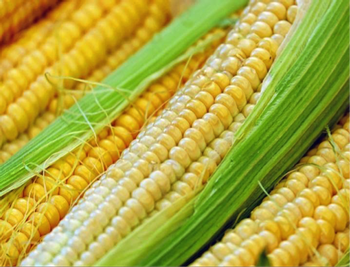Corn
-
Scientific NameZea mays
-
General InformationSweet corn is a warm season, fast growing, annual crop. Needs warmth, space, well-drained, rich soil, and generous irrigation. Corn is in the Poaceae family (Grass) and is technically a grain, considered a fruit, but also commonly categorized as a vegetable. It descended from a Mexican grass called teosinte.

-
When to Plant
Plant as soon as possible after the last frost date to get the most out of the growing season, from late April to the middle of July. Seeds planted in soil less than 60 degrees may not germinate properly. Plant successive crops two weeks apart to get continued harvest through the fall, using the earliest varieties for later plantings.
-
Planting
Plant seeds directly in soil in full sun. Roots are sensitive to transplanting. Plant one and a half to two inches deep and 12 inches apart. Place two kernels in each spot an inch apart. When the plants are three to four inches tall, thin to one plant every 12 inches. Because corn is wind pollinated, plant in a minimum four foot by four foot block. Different varieties should be 400 yards apart to prevent cross-pollination. Corn can reach five to 10 feet tall, so leave room for the growth and for plants that may get shaded out. Use supports if the site is particularly windy.
-
Soil Requirements
Plant in rich, composted soil high in organic matter. Moisture retentive, well-draining soil works best. Mulching provides moisture and helps keep weeds out. Corn tolerates many soils types, pH 5.8 to 6.8 works well.
-
Water Requirements
Water one to two inches a week depending on heat and wind, do not let it dry out during pollination process or you may be left with deformed kernels
-
Fertilizing
Corn is a heavy feeder and grows quickly. If beds have been adequately prepared prior to planting, only nitrogen will be needed during the growth cycle. If amendments have not been added prior to planting, fertilize with a premixed N-P-K fertilizer in the range of 5-10-5 to 16-16-8 available from your local nursery. These blends contain different combinations of bone meal, fish meal, blood meal, kelp etc. Stalks can fall over (lodging) if they are over-fertilized. Yellowing leaves indicate nitrogen deficiency.
-
Pollination
Corn is self-pollinating. Pollen from the tassels (male) is blown by the wind onto the silks (female), where each individual silk strand fertilizes one kernel within the ear. The tassels and silks must be ready at the same time in order to fully fertilize the ear of corn, and cool temperatures may impede this process.
-
Harvesting
Ears are ready for harvest about 60 to100 days from planting, depending on variety, and about three weeks after the first silk strands appear. Heat can speed up the timing and cool weather can prolong maturation. Harvest corn when silks have started to dry and turn brown and the husks are still green. Pull the ear down and twist to remove from the stalk. Leave as many leaves as possible on the ear to maintain moisture. Each plant can produce two to three ears. Leave the suckers. After harvesting the ear, try a taste of the stalk -- it is very sweet! Kernels should be full-sized up to the tip of the ear. Some ears will not fill out to the tip, so check a bit further down the ear to be certain. When a kernel is punctured, the liquid should be milky. If it is clear, it is not ready. If it is white, it is overripe. Pick in the morning as field heat will increase the conversion of sugars to starch. Submerge in cold water or put on ice before refrigeration.
-
Storage
Store corn in the refrigerator. Eat as soon as possible to capture sweetness. Cut kernels off the cob and freeze for later use.
-
Good Varieties for Marin
Yellow: ‘Early Sunglow’ ‘Kandy Korn’ ‘Jubilee’ ‘Early Xtra Sweet’
White: ‘Argent’ ‘Silver Queen’ 'How Sweet It Is’
Bicolor: ‘Double Gem’
Dwarf: ‘Candystick’
-
Helpful Tips
Plant in blocks (not long rows) for optimal pollination. Do not let plants dry out. Check often for ripeness.
-
Common Problems
Underdeveloped or “blank” kernels -- due to inadequate water or insufficient pollination. Harvesting too early or too late. Cross pollination with other varieties.
-
Pests- Diseases & More
Aphids, slugs and snails, worms, mosaic virus, rust, fungi, cutworms and corn smut.

